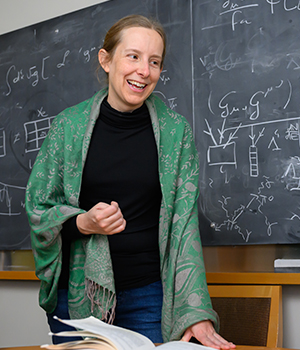
Tracy Slatyer
(they/them or she/her)
Physics
Seeing the PhD as a Journey
“While professors at MIT are known for being world-class researchers, and many are stellar lecturers, mentors, or great contributors to their community, I can’t say I know many who are all of the above,” begins a nomination letter. “However, Tracy Slatyer is one such professor, and that is why we are nominating them for this award.”
Prof. Tracy Slatyer is a theoretical physicist who works on particle physics, cosmology, and astrophysics. Focused on unraveling the mysteries of dark matter, they investigate potential new physics through the analysis of astrophysical and cosmological data, exploring scenarios involving novel forces and theoretical predictions for photon signals. Notably, they co-discovered the giant gamma-ray structures known as the “Fermi Bubbles” erupting from the center of the Milky Way.
Seeing the PhD as a Journey
One of Tracy Slatyer’s key approaches is to prioritize their students’ development into independent researchers over academic accomplishments alone, also acknowledging the prevalence of imposter syndrome among students. Having struggled with imposter syndrome in graduate school themselves, Slatyer shares their personal past challenges and encourages students to see the big picture: “I try to remind them that the PhD is a marathon, not a sprint, and that once you have your PhD, nobody will care if it took you one year or three to get through all the qualifying exams and required classes.” Many students also expressed gratitude at Slatyer’s efforts to connect outside of work, such as extending invitations to tea-time.
Slatyer encourages students to seek advice and mentorship from a range of colleagues at different career stages, and to explore their interests even where those lie outside their advisor’s primary field of research, including building connections with other professors. They believe in supporting community amongst students and postdocs, and the value of a broad and robust network of mentors to guide students in achieving their individual goals.
Slatyer never misses an opportunity to advocate for their students both personally and academically. In addition to their role as an advisor, Slatyer has served as a driving force behind the Physics Values Committee. As the faculty chair, they made several recommendations for improving graduate advising and led the way by implementing the changes within their own group.
Realistic expectations
Many advisees noted Slatyer’s realistic portrayal of expectations within the field and open discussion of work-life balance. Slatyer maintains an advising document with clear guidelines for both they and their advisees. When a student is just beginning the research portion of their PhD, Slatyer makes sure to either work with them directly or place them on projects with senior students or postdocs. They also set aside meetings with students to discuss non-research related matters, such as career goals or upcoming talks and conferences.
In addition, Slatyer does not shy away from the fact that their field is competitive and demanding. They try to be candid about their experiences in academia (both negative and positive), noting that the support and advice they have received from a diverse range of mentors have been key to their own successful career.
“In all honesty,” writes one nominator, “being in a field as competitive as high energy physics, it is unrealistic and harmful to portray an expectation that what we do is a 9-to-5, weekdays only job… Tracy, of course, asks about the post-graduate plans… and would discuss expectations and the state of the academia explicitly.”
